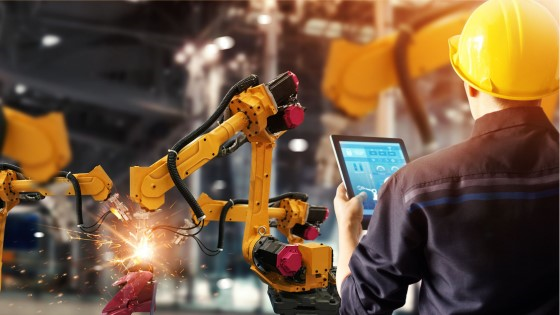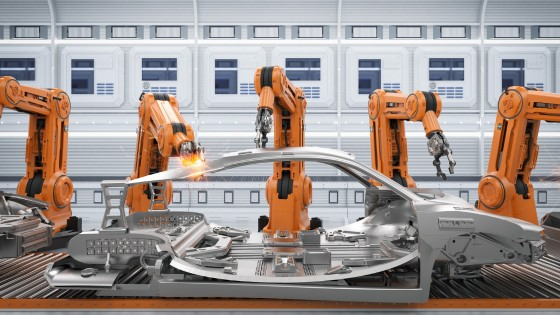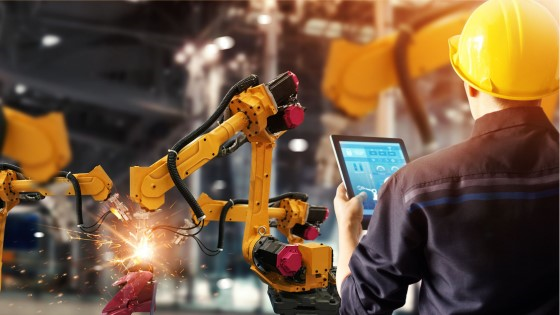
The use of robotics is creating a new era of efficiency and innovation for manufacturers and engineers. Integrating robots in manufacturing is not just a trend - it’s a significant shift transforming how we make products and deliver services.
Takahiro Ishibashi, Spatial’s APAC Expert Solution Architect, an innovator in industrial automation and robotics software, explains this transformation perfectly.
They state, "Robots are no longer a novelty in the manufacturing world. They are at the forefront of a revolution, driving unprecedented levels of precision, productivity, and safety. The future of manufacturing is not just about adopting robots, but about harnessing their full potential to redefine what's possible in production processes."
In 2021, over 517 385 industrial robots were installed in factories across the world. This was an all-time high. However, with an annual CAGR of 11.4% expected from the industrial robot market for the years 2023-30, we should expect to see even more manufacturers take the robot plunge.
A Brief History of Robots In the Manufacturing Industry
When compared to the entire history of manufacturing, robots are a relatively new tool. Robots’ abilities to automate, streamline and speed up productivity are surpassing everyone's expectations at an alarming rate, and they’ve fast become a favored solution by industry leaders.
Let’s take a look at the brief (but very impactful) history of robotics in manufacturing.
- In 1937, Griffith B. Taylor created the first known industrial robot that had a single electric motor and five axis of movement and could stack wooden blocks in patterns.
- In 1954, the first industrial robot patent was filed by George Devol. His robot could move items within a 12-foot radius.
- In 1962, a robot called Unimate was introduced into a General Motors assembly line, revolutionizing car manufacturing.
- The 1970s saw the advent of programmable robots, which brought increased flexibility and efficiency to production lines.
- Fast forward to the 21st century, and we see the rise of collaborative robots, or "cobots," designed to work alongside human operators, enhancing safety and productivity.
We all know this is just the beginning. The next wave of robotics innovation promises to further the industry, making manufacturing processes more efficient, safer, and more adaptable than ever before.
Robotic innovations in manufacturing evolve everyday. Stay in the know with help from the Spatial blog:
How are Robots Used in Manufacturing Today?
Robots have become an integral part of modern manufacturing, playing diverse roles that enhance efficiency, safety, and quality. Let’s explore how the robotics used in manufacturing are shifting patterns and trends.
Automation of Repetitive Tasks
One of the primary uses of industrial automation robotics is in the automation of repetitive tasks. Robots can tirelessly perform the same task with consistent precision, reducing costs associated with human error and increasing productivity.
Precision
Robots are renowned for their precision. They can be programmed to perform intricate tasks requiring a high level of accuracy, significantly enhancing precision and accuracy parameters in manufacturing processes.
Hazardous Work Environment
Robots can be deployed to do tasks in hazardous work environments, such as ones with high temperatures, that require exposure to toxic substances, or heavy machinery. This not only improves workers' safety but also allows for more consistent production under conditions that would be challenging for humans.
Quality Inspection and Testing
Quality control is a foundation of good manufacturing, and robots play a vital role in ensuring quality parameters are met. Robots equipped with advanced sensors and vision systems can perform detailed inspections and testing.
They can detect defects, measure dimensions, verify product integrity, and conduct various tests, enhancing overall quality assurance and reducing human error.
Material Handling and Logistics
Robots play a crucial role in material handling and logistics within manufacturing facilities. They can efficiently transport raw materials, components, and finished products across different stages of production.
By leveraging a robot's speed, accuracy, and ability to work tirelessly, manufacturers are better able to streamline their supply chains and optimize inventory management.

Industries That Rely on Robots for Manufacturing
Several industries are relying more heavily on robots for manufacturing processes than ever before. As such, robots are becoming a normal sight in manufacturing facilities and plant floors around the globe.
Examples of industries that utilize advanced robot technology as part of their manufacturing operations include:
- Automotive Industry: Automotive robots play a crucial role in the car industry. They are used to perform tasks that can range from welding and painting to part assembly and quality control inspections.
- Electronics Industry: In the electronics industry, robots are used for assembling delicate components, quality control testing, and even for product packaging.
- Food and Beverage Industry: Sorting, packaging, and palletizing, are key tasks in the food and beverage industry. Robot use ensures speed and hygiene needs are met.
- Pharmaceuticals and Healthcare Industry: Robots are used for precision tasks needed when working with medical supplies and patients. This includes tasks such as raw materials mixing, packaging, and some types of patient care.
The Role of 3D Modeling in Robotics for Manufacturing
To make robots work as intended, we need software that can effectively control and program these machines. The primary software used for robots in manufacturing is 3D modeling software, the importance of which cannot be overstated.
This is because 3D modeling plays a vital role in how we use robots in manufacturing and fabrication solutions. It facilitates process designing, simulation testing, product and process optimizations, and more. The right software can also ease communication for engineers and designers working in manufacturing.
Enhancing Product Design and Prototyping
3D modeling enables manufacturers to create accurate digital representations of products and prototypes. This technology allows designers and engineers to visualize and refine product designs in a virtual environment as well as test prototype accuracy before moving to physical production.
With 3D modeling tools such as 3D InterOp, precise details can be added, dimensions can be adjusted, and potential design flaws can be identified early on. This streamlines the overall design process and shortens the process and product development times.
Process Simulation and Optimization
One of the key advantages of 3D modeling lies in its ability to simulate and test manufacturing processes. By creating digital replicas of the manufacturing environment, 3D models allow manufacturers to analyze and optimize various aspects of production.
These simulations can identify potential bottlenecks, optimize assembly sequences, optimize material flow, and even evaluate ergonomics for human-robot collaboration. This virtual testing and optimization lead to more efficient and streamlined production processes, reducing costs and increasing productivity.
6 Benefits of Manufacturing with Robotics
Manufacturing with robotics offers a multitude of benefits that significantly impact productivity, quality, safety, and cost-effectiveness. By leveraging the capabilities of robots in manufacturing processes, businesses can unlock numerous advantages.
Here are six benefits of manufacturing with robotics:
- Increased Efficiency and Productivity: Robots can automate repetitive tasks, work at high speeds, and provide consistent performance. All of these features increase production and efficiency levels.
- Enhanced Quality Control: With advanced precision and accuracy, products made with robots tend to meet higher quality control requirements than if made by hand.
- Better Workplace Safety: Robotics can be used to handle dangerous tasks such as moving hazardous materials, painting with toxic coatings, and lifting heavy objects. This reduces the risk of workplace accidents and injuries.
- Cost Savings: By replacing or augmenting human workers with robot solutions, labor costs are reduced, and production levels rise, helping products be made in less time, for less money, and with better quality controls.
- Greater Flexibility and Adaptability: Robots can be programmed and reprogrammed to perform various tasks in the blink of an eye. This enables manufacturers to quickly adapt to changing production requirements and market demands.
- Scalability and Consistency: Robotic automation allows for easy replication and quick scalability in manufacturing processes, ensuring consistent output even in high-volume production scenarios.
Real-World Examples of Manufacturing Robots
Knowing how and where manufacturing companies are using robots is good to know, but it doesn’t provide a complete picture of how robotics is streamlining production processes.
Below are three real-world examples of how robots are impacting the manufacturing industry.
Articulated Robots
Articulated robots are versatile and widely used in manufacturing due to their ability to mimic the movements of a human arm. They consist of multiple joints (like elbows) that enable them to perform complex tasks with precision.
For example, In the automotive industry, articulated robots are used for:
- Welding car bodies
- Assembling components
- Painting vehicles
- And more
Cartesian Robots
Cartesian robots, also known as gantry robots, use a three-axis Cartesian coordinate system that allows them to move in a linear and perpendicular manner. They are commonly used to pick up items and place them in a new spot with precision.
In electronics manufacturing, this is critical for building circuit boards. The cartesian robots can accurately and quickly place circuit board components in the right spot during the assembly process.
SCARA (Selective Compliance Assembly Robot Arm)
SCARA robots are specifically designed for assembly and handling tasks. They feature rigid vertical movement combined with compliant horizontal movement, allowing them to perform tasks with speed and accuracy.
SCARA robots are used in multiple industries for tasks such as:
- Screw driving
- Soldering
- Repetitive parts assembly.
Their fast and precise movements make them ideal for high-speed assembly lines.
Build Better Manufacturing Workflows With SDKs for Manufacturing Robots
Robotics has opened up exciting opportunities for increased efficiency, innovation, and growth for manufacturers. It’s allowing manufacturers to streamline production processes, boost productivity and create better working conditions for staff.
Our SDKs provide advanced interoperability and integrated solutions. You can streamline your programming processes, improve accuracy, and ultimately enhance your manufacturing outcomes.
Embrace the power of Spatial's solutions and unlock the full potential of your manufacturing robots. Contact us today.

